 Revolve
Revolve
![]()
![]()
![]()
Create, add to, subtract from, or intersect parts by revolving sketch regions or planar faces about a central axis, or surfaces by revolving lines and curves about a central axis.
Shortcut: Shift+w
The Revolve feature allows you to create, add to, subtract from, or intersect parts by revolving sketch regions or planar faces about a central axis, or surfaces by revolving lines and curves about a central axis.
Click the Revolve feature on the feature toolbar. Select the Faces and sketch regions to revolve. Here, the circle on Plane 1 is selected. Click the Revolve axis field in the dialog and select a line or curve in the graphics area. You can also select an implicit or explicit Mate connector's Z axis. Click the Mate connector icon in the dialog and select or create a Mate connector in the graphics area.
By default, the New type is selected, which creates a new part. Select Add to add the revolved part to the parts that intersect the revolve path. If multiple parts exist, the Merge scope field in the dialog has focus. Select a part in the graphics area to use as a merge scope, or check Merge with all to merge with all parts intersecting the revolve path. Select Remove to remove the revolve from the existing parts in the merge scope, or Intersect to keep only the intersection of the revolve and the parts in the merge scope.
Select a Revolve type. Full revolves 360 degrees about the axis. One direction revolves in one direction for a specified number of degrees. Enter the degrees in the dialog or use the arrow in the graphics area. Click the arrow icon in the dialog to flip the revolve in the opposite direction. Symmetric revolves in both directions for a specified number of degrees. Two directions revolve in both directions for the same or different numbers of degrees. Enter a Second revolve angle or use the double-headed arrow in the graphics area to adjust the second revolve angle.
Click the checkmark to accept the new Revolve feature.
From the Sketch or Feature toolbar:
- Click
 .
.

- Select
Solid
Creation type:
When Revolve Solid is selected at the time a sketch is open, Onshape automatically selects all the closed regions in the sketch.
Onshape remembers the selection (Solid, Surface, or Thin) and opens the dialog with the last selected option in subsequent operations.
- Select a line, cylindrical edge, or arc to revolve around an axis, or Mate connector (implicit or explicit).
- Activate the Revolve axis field, then click the axis or click the
 in order to select implicit Mate connectors about which to revolve.
in order to select implicit Mate connectors about which to revolve.
Once a Mate connector is selected, click the Mate connector icon in the dialog field (outlined in blue below) to open a dialog with which to edit the Mate connector:

Click the Mate connector icon to create an implicit Mate connector in the graphics area
- Choose whether you want to:
- New - Create a new solid
- Add - Add to an existing solid
- Remove - Subtract from an existing solid
- Intersect - Keep the intersection of two (or more) solids
- Select a Revolve type:
- Full - Revolve about the axis 360 degrees
- One direction - Revolve in one direction for a specified number of degrees
- Symmetric - Revolve in both directions for a specified number of degrees
- Two directions - Revolve in both directions for the same or different numbers of degrees
- If necessary, select a Merge scope (or Merge with all) to select parts or surfaces with which to merge the new (additional) part or surface.
-
Click
 .
.
From the Sketch or Feature toolbar:
-
Click
 .
.
- Select Surface Creation type:
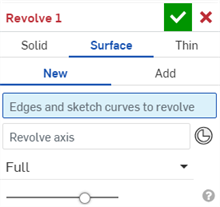
Onshape remembers the selection (Solid, Surface, or Thin) and opens the dialog with the last selected option in subsequent operations.
- Choose whether you want to:
- New - Create a new surface
- Add - Add to an existing surface
- Select edges or a sketch to revolve.
- Activate the Revolve axis field, then click the axis or Mate connector (implicit or explicit) about which to revolve.
Once a Mate connector is selected, click the Mate connector icon in the dialog field (outlined in blue below) to open a dialog with which to edit the Mate connector:

- Select a Revolve type:
- Full - Revolve about the axis 360 degrees
- One direction - Revolve in one direction for a specified number of degrees
- Symmetric - Revolve in both directions for a specified number of degrees
- Two directions - Revolve in both directions for the same or different numbers of degrees
- If necessary, select a Merge scope (or Merge with all) to select surfaces with which to merge the new (additional) surface.
-
Click
 .
.

From the Sketch or Feature toolbar:
-
Click
 .
.
- Select Thin Creation type:
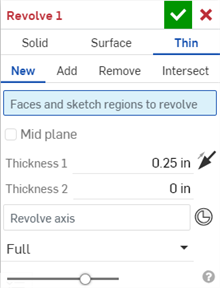
Onshape remembers the selection (Solid, Surface, or Thin) and opens the dialog with the last selected option in subsequent operations.
- Choose whether you want to:
- New- Create a new solid
- Add- Add to an existing solid
- Remove- Subtract from an existing solid
- Intersect- Keep the intersection of two (or more) solids
- Select faces or sketch region to revolve.
- Do one of the following:
- To create a revolve with a symmetric thickness, check the Mid plane option and then enter the Thickness value.
- To specify individual wall thicknesses, uncheck the Mid plane option. Then, enter the Thickness 1 wall value and Thickness 2 wall value. Click the Flip wall arrow to flip Thickness 1 with Thickness 2.
- Activate the Revolve axis field, then click the axis or Mate connector (implicit or explicit) about which to revolve.
Once a Mate connector is selected, click the Mate connector icon in the dialog field (outlined in blue below) to open a dialog with which to edit the Mate connector:

- Select a Revolve type:
- Full - Revolve about the axis 360 degrees
- One direction - Revolve in one direction for a specified number of degrees
- Symmetric - Revolve in both directions for a specified number of degrees
- Two directions - Revolve in both directions for the same or different numbers of degrees
- If necessary, select a Merge scope (or Merge with all) to select solids with which to merge the new (additional) solid.
-
Click
 .
.
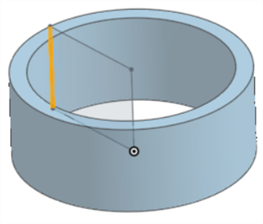
New - Create new material that results in a new part.
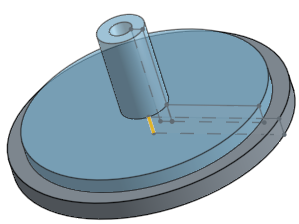
Add - Create material and add to the existing material.

When adding material, you have the option to merge that material with other parts that touch or intersect its geometry:
- If the geometry touches or intersects with only one part then that part is automatically added to the merge scope.
- If multiple parts touch or intersect the geometry, then there is ambiguity and you must select which parts to merge with (the merge scope).
- A shortcut to selecting multiple touching or intersecting parts, you have the ability to check Merge with all to add all touching or intersecting parts to the merge scope.
If the Boolean is set to Add, Remove, or Intersect and nothing is set in the merge scope, the feature will result in an error. For New, no merge scope is available since New does not boolean the result.
Take material away:

Leave material only where intersections exist:

Full
Revolve about the axis 360 degrees:

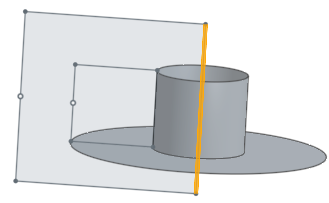
One direction
Revolve in one direction for a specified angle:


Two Directions
Revolve in two directions for specific angles:


Symmetric
Revolve in both directions for the same angle:


Project a selected region or planar face about an axis or Mate connector (implicit or explicit). Create a new part or modify an existing one by adding or removing material, or intersecting parts in its path. You also have the ability to create parts or surfaces.
Merge scope is available with parts and surfaces and allows you to select the specific part or surface with which to merge the newly created part or surface. By default, Merge all is selected. You are able to uncheck that box to access the Merge scope field, then select the part or surface with which to merge. Surfaces must be merged with surfaces and parts with parts.
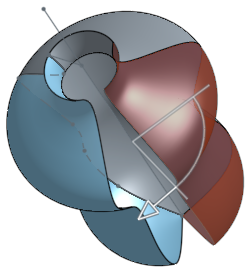

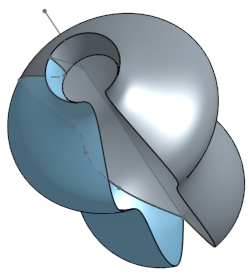
Merge scope: with all
Merge with all parts that touch or intersect the geometry being created:
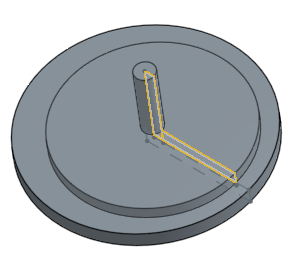
Merge scope: with specific part
Merge with selected part:

- Tap Revolve tool.


- Select Creation type:
- Solid - Create parts or modify existing parts by revolving a sketch region or face about an axis.
- Surface - Create a surface by revolving a sketch curve or edge about an axis.
- Thin - Create a thin revolve along a sketch region or face.
- Select a Result body operation type:
- New - Create new material.
- Add - Create material and add to the existing material.
- Remove - Take material away.
- Intersect - Leave material only where intersections exist.
- Select Faces and sketch regions to revolve.
- Select an axis about which to revolve.
Optionally, tap to activate the Revolve axis field, then click the axis or tap the Mate connector icon in order to select or create implicit Mate connectors about which to revolve.
- Select a Revolve type:
- Full - Revolve about the axis 360 degrees.
- One direction - Revolve in one direction for a specified angle.
- Symmetric - Revolve in both directions for the same angle.
- Two directions - Revolve in two directions at the same angle OR two different angles.
- Tap checkmark.
New - Create new material that results in a new part

Add - Create material and add to the existing material

When adding material, you have the option to merge that material with other parts that touch or intersect its geometry:
- If the geometry touches or intersects with only one part then that part is automatically added to the merge scope.
- If multiple parts touch or intersect the geometry, then there is ambiguity and you must select which parts to merge with (the merge scope).
- A shortcut to selecting multiple touching or intersecting parts is you can check Merge with all to add all touching or intersecting parts to the merge scope.
If the Boolean is set to Add, Remove, or Intersect and nothing is set in the merge scope, the feature will result in an error. For New, no merge scope is available since New does not boolean the result.
Remove - take material away
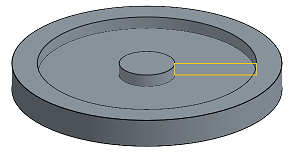
Intersect - Leave material only where intersections exist

Create a surface along a sketch curve.

These examples all show the revolve of a simple part or surface, creating new material.
Full
Revolve about the axis 360 degrees.
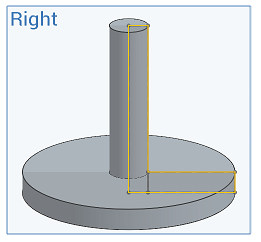

One direction
Revolve in one direction for a specified angle.


Symmetric
Revolve in both directions for the same angle.


Two directions
Revolve in two directions at the same angle OR two different angles.


- Tap the Revolve tool icon (
 ).
).
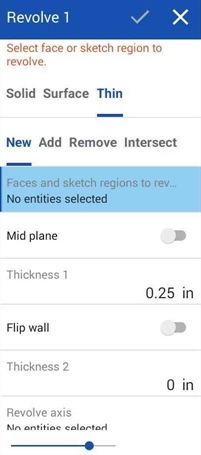
- Select Creation type:
- Solid - Create parts or modify existing parts by revolving a sketch region or face about an axis.
- Surface - Create a surface by revolving a sketch curve or edge about an axis.
- Thin - Create a thin revolve along a sketch region or face.
- Select a Result body operation type:
- New - Create new material.
- Add - Create material and add to the existing material.
- Remove - Take material away.
- Intersect - Leave material only where intersections exist.
- Select Faces and sketch regions to revolve.
- Select an axis about which to revolve.
- Select a Revolve type:
- Full - Revolve about the axis 360 degrees.
- One direction - Revolve in one direction for a specified angle.
- Symmetric - Revolve in both directions for the same angle.
- Two directions - Revolve in two directions at the same angle OR two different angles.
- Tap checkmark.
New - Create new material that results in a new part

Add - Create material and add to the existing material

When adding material, you have the option to merge that material with other parts that touch or intersect its geometry:
- If the geometry touches or intersects with only one part then that part is automatically added to the merge scope.
- If multiple parts touch or intersect the geometry, then there is ambiguity and you must select which parts to merge with (the merge scope).
- A shortcut to selecting multiple touching or intersecting parts is you can check Merge with all to add all touching or intersecting parts to the merge scope.
If the Boolean is set to Add, Remove, or Intersect and nothing is set in the merge scope, the feature will result in an error. For New, no merge scope is available since New does not boolean the result.
Remove - take material away:

Intersect - Leave material only where intersections exist:

Create a surface along a sketch curve:

These examples all show the revolve of a simple part or surface, creating new material.
Full
Revolve about the axis 360 degrees:


One direction
Revolve in one direction for a specified angle:


Symmetric
Revolve in both directions for the same angle:


Two directions
Revolve in two directions at the same angle OR two different angles:

